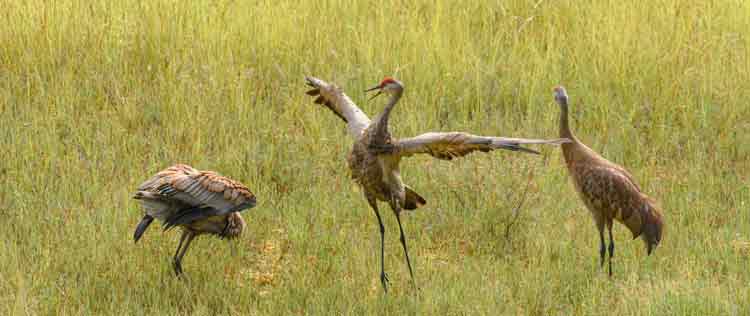



Cranes trumpet intent, mood, and specific messages through iconic body language. Dancing expresses individual emotional highs, like elation upon return from migration. As male-female pairs dance, their reciprocal postures promote stronger pair bonding.
The dance displays on this webpage encompass the basic repertoire for many Alaska Sandhill Cranes. Individual cranes develop their own styles. Crane dance starts from nature, movements programmed in DNA, and is modified by nurture, parental teaching and life experience. Experienced cranes incorporate diverse steps and postures (including high arousal attack poses like Bows and Jump-rakes) into spontaneous flowing performances like the Tour-jeté and Minuet below.
read more...Dancing plays different roles as cranes mature:
For young colts dancing strengthens muscles, improves motor coordination, and facilitates communication skills. From the time of hatch, parents encourage young colts to run, to flap, to jump, and to dance. Dancing promotes family bonding and is an expression of joy.
For yearlings and young cranes in "teen-age gangs" on staging areas and in foraging flocks, practice dancing refines postures, steps, sequences, and routines, but even more important, dancers size-up one another by challenging and by flirting.
For mated pairs of cranes who dance on winter roosting grounds, migratory staging areas, and summer nesting territories, dancing is a postural conversation that synchronizes emotions. As nesting time approaches in the spring, dancing may well promote hormonal changes that hasten reproductive maturation.
Display: Nech arched up and bill pointed vertically. Wings are lifted and spread.
Very rare display; see Ice dancing 2009 for context of this Arch display.
Function: Very high arousal dancing.

We live on 40 acres of permafrost near Fairbanks, Alaska.
For 24 years, Christy Yuncker Happ has recorded the passing of the seasons in her written journals, still images, and videos.
George Happ is responsible for this website and the Alaska Sandhill Crane Blog.
Christy Yuncker Happ
We welcome your emails
and your crane stories.